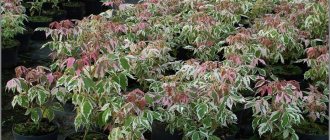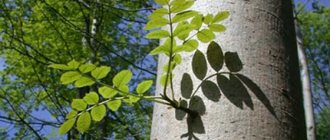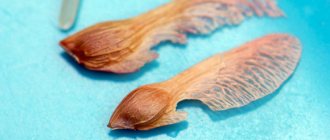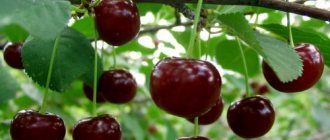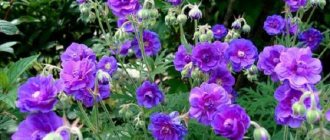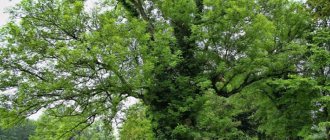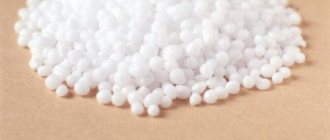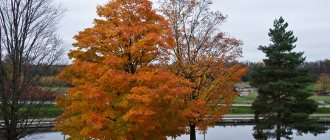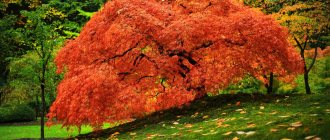In our country, it is often called “Negundo maple”, “California maple”, “killer maple” or incorrectly called ash. Its roots, and when rotting and litter, release arboricides (phytotoxicants that attack trees and shrubs). By settling, for example, in floodplain forests, it prevents the regeneration of our poplars and willows. And it is almost impossible to destroy the “killer”.
Ash-leaf maple, or American (lat. Acer negundo) is a species of the genus Maple, family Sapindaceae. This deciduous tree is native to central and eastern North America. It was introduced to other continents: South America, Australia, Africa and Eurasia. The species was brought to Russia in the 18th century, it self-sowed throughout the country and began to pose a threat to native plant species.
What does ash maple look like?
This tree is up to 10-25 m high, with a trunk diameter of 30-50 cm, rarely up to 1 m. Its appearance (hibitus) depends on the habitat. If the maple grows separately or in light, uncrowded forests, it is an upright tree with one well-developed trunk. In close plantings, its trunk and crown , bending, occupy a convenient position in relation to the light and emerge from the shadow of other trees. Then it becomes twisted, with a drooping crown.
Often the trunk begins to branch at a level of 0.5-5 m from the ground, which is associated with damage to its top by pests, frosts or diseases. In this case, many shoots develop from dormant buds at the base of the trunk. Over time, most of them die off, leaving only 5-7 daughter trunks. Then the life form of the maple becomes outwardly similar to a bush.
The root system of the plant is fibrous and superficial, but strong, holding it well from windfall. Male trees produce numerous root suckers, which is why the species often forms impenetrable thickets. On loose soils, maple forms a short taproot with strong lateral shoots.
The trunk is covered with thin, pale gray or light brown bark , deeply grooved. Young annual shoots are dark green, with a bluish, reddish-brown or purple waxy coating, making them glossy. The wood is soft yellowish-green, the pith is white and friable.
buds are ovoid, fluffy, and white. Axillary buds are sessile, obtuse. Maple leaves are located opposite on the branches. They are somewhat similar to the leaves of an ash tree, hence its name - ash leaf.
The leaves are compound, deeply dissected, less often trifoliate, odd-pinnate, usually with 3, 5 or 7 toothed blades. They are silvery-white below, light green above, and yellow in autumn. They are held on petioles, 5-8 cm long.
Unlike most maples, this is a completely dioecious tree, blooming in March-April, long before the leaves bloom.
Flowers are often without petals. Male (staminate) flowers with reddish anthers are collected in clusters, hanging on pedicels up to 6 cm long. Female (pistillate) greenish flowers are grouped into an inflorescence raceme, have thick short pedicels 6-8 mm long, which, when the fruit is formed, lengthen to 2-3 cm.
The fruits are paired lionfish, 3.5-4.8 mm long, diverging at an acute or right angle, with narrow straight nuts. At first green, when ripe they turn light brown. They ripen and fall in September, some of them remain on the tree throughout the winter.
Differences between ash-leaved maple and Norway maple (lat. Acer platanoides)
Norway maple is also widespread in our country and is often cultivated in gardens and parks. The differences between these two types are clearly visible. Here are just a few of them.
- Norway maple lives up to 150 years, American maple - no more than 100 years.
- The height of the Norway maple reaches 28 m, the ash-leaved maple does not exceed 25 m.
- The leaves of the Norway maple are simple lobed, while the leaves of the American maple are compound.
- The flowers of Norway maple are yellowish-green, while those of ash maple are either reddish or greenish.
- The buds of the Norway maple are reddish-green, while those of the ash maple are pubescent and white.
- Norway maple bark is rougher and more rugged.
- The single trunk and branches of the Norway maple are always directed upward; in the ash-leaved maple they are often curved, and there may be several daughter trunks.
Advantages and disadvantages of ash maple
American maple is a pollution-resistant, unpretentious soil composition, fast-growing species. But it still feels better in fertile, well-drained soils.
Read also: Lamp replacement device
The maple reaches maturity by 10-15 years. But it does not live long, only 60, less often 100 years.
Prefers bright sunlight. It settles in floodplain meadows, near lakes and rivers, on human-disturbed lands, for example, in wastelands near settlements, in lowlands and other places with sufficient water.
Advantages of American maple:
- drought and smoke resistance;
- ability to grow on different types of soil;
- speed of spread by self-seeding and with the help of root suckers;
- the ability to clean the air well due to the high rate of photosynthesis;
- rapid decomposition of plant litter;
- high rate of biomass recovery after fires.
Disadvantages of ash-leaved maple:
- low frost resistance. Young shoots may freeze slightly in winter;
- for growth they need close-lying groundwater (no deeper than 2 m);
- high fragility of branches and susceptibility of roots to rot;
- fragility;
- a large amount of pollen that causes allergies in people;
- when parts of the tree decay, they produce poisons that prevent the growth of other plants;
- root growth disrupts the structure of plantings and spoils the asphalt;
- Wood is susceptible to infection by many types of pests.
Application
In its homeland in North America, maple was used as a sugar plant. In spring its juice is very sweet.
Maple wood is fragile, soft, light and fibrous. It is processed with great difficulty. It contains a lot of water and requires a long drying time. Therefore, it is almost never used as firewood. But its fibers are used to make fiberboard and containers.
The tree is unsuitable as a green hedge, since its active shoots appear in unplanned places, but it is suitable for quickly and cheaply achieving a landscaping effect.
It is indispensable for planting forest and windbreaks, to combat soil erosion, to strengthen the banks of reservoirs, etc.
Due to its early flowering, the species is suitable for planting near apiaries. Honey collected by bees from its flowers is sold in Belovezhya and Poland.
Despite irregularly shaped trunks, branches prone to breaking and many other disadvantages, the tree is actively used for urban landscaping.
Several interesting varieties have been developed that are superior in decorativeness to the main form:
"Auratum" is a variety with lemon-colored leaves, an arched trunk and twisting branches. "Aureomarginatum" leaf edges are creamy yellow. "Baron" is a seedless and hardier variety. “Elegans” the leaves of trees of this variety are convex, with a border, young ones are bright yellow, mature ones are white. "Flamingo" is a very popular form of maple with white and pink patterns on the leaves.
The developed decorative maple varieties are distinguished by high resistance to frost and other positive qualities. They are actively used as an object in landscape design.
For many peoples, ash was a sacred tree. Its wood was valued on a par with ebony and mahogany. People have been eating the fruits for a long time, and the leaves, fruits and bark were used to treat various diseases.
Ash is often confused with ash maple, so first let’s figure out how these trees differ.
- First of all, it should be noted that they belong to different families: ash - to the Maslinaceae family, ash maple - to the Mapleaceae family.
- Further: ash leaves have a darker green compared to maple; In maple, as a rule, the apical leaf of a compound leaf has a characteristic dissected shape.
- And the most obvious difference is the fruits. Ash lionfish are single, lanceolate or oblong-elliptic, graceful, with a small notch at the top. The seed is elongated, flat, furrowed, half the length of the shell. The ash-leaf maple has double lionfish, slightly crescent-shaped, there is a notch on the side, the seed is wrinkled and is difficult to separate from the shell.
Both trees reproduce well by self-sowing. In our area they are found everywhere in forests, parks, and along roads.
An ash tree living in the open air delights with its bright grandeur; it is not for nothing that Dahl believed that the word “ash” comes from the word “clear” (“light”). Indeed, the branches of the ash tree are thick, but sparse, and the foliage transmits sunlight well. In addition, ash has light bark, which is also associated with light.
Read also: Grow prunes from seeds at home
It is not for nothing that Lithuanian legend says that having descended to earth, the gods settled down in the shade of a spreading ash tree, under which it was light and cool. The gods came to people to decide their destinies. Since then, Lithuanians have called ash the tree of the righteous.
In all Slavic languages, the name of this tree sounds almost the same, and the British call it an ash tree for the color of its bark.
Trees from the Ash genus rise in height up to 25-35 meters, some specimens up to 60 meters, the diameter of the trunk of an old tree can reach a meter.
Photo: Depositphotos
Ash is a light-loving and frost-resistant tree. Under favorable conditions, it lives up to 300 years or more. It begins to bear fruit at the age of 25−40, although there are early specimens that bloom at 10−15 years.
It blooms before the leaves bloom, which ensures good pollination; fruits (nuts) are produced annually in large quantities. Nuts contain a lot of fat and protein, so they are a favorite food of squirrels, birds and rodents.
The nutritious fruits were also eaten by people. For example, the British preserved unripe fruits and seasoned meat and vegetable dishes with them. In the Caucasus, a spicy seasoning is still prepared from ash fruits.
Ash sap has long been used to produce a sugar substitute.
Even in ancient Rome, ash fruits were used to treat diseases of the liver, dropsy, and respiratory organs. The leaves and bark were used as a laxative, diuretic, disinfectant and wound-healing agent.
Manna ash (Fraxinus ornus). Botanical illustration from the book Köhler's Medizinal-Pflanzen, 1887. Photo: ru.wikipedia.org
Many peoples believed that ash leaves and sap paralyzed vipers, and therefore planted it near their homes. Nowadays, ash is sometimes used as a hedge.
Ash leaves are an excellent food for pets. Ash is also good as firewood - it burns well even when fresh.
Nowadays, official medicine uses tincture of ash fruits for varicose veins. Mannin powder is obtained from the juice, which is used as a sugar substitute for those suffering from diabetes.
With all the beneficial qualities of ash, you should know that its pollen is a strong allergen. In some countries it is not recommended to plant it in populated areas.
Nevertheless, decorative forms have been developed that look very impressive in parks and gardens. In addition, this tree is extremely resistant to air pollution, which also gives it a chance to be planted in urban areas.
Margarette Walti, “Ash” Photo: artchive.ru
Ash wood is resilient and durable, its color ranges from creamy white to light brown and has a beautiful texture. The heartwood may be olive brown.
On the trunks there are burls (growths) that have an original texture. They are a valuable material from which small but expensive crafts are made.
Even the ancient Romans made darts and spears from ash, and the Slavic peoples made arrows, bows, clubs, spears, shafts, and skis. The wood was used not only for military and hunting purposes; it was used to make beautiful carved dishes, handles for axes and hammers.
Seasoned ash boards were valued by shipbuilders. For example, skilled Scandinavian shipbuilders mainly used ash to build their famous ships.
Ash wood Photo: ru.wikipedia.org
Carriages, sleighs, rocker arms, oars, skis, barrel hoops, and canes were made from ash. Nowadays, the popularity of this tree has not faded: skis, racing oars, poles for gymnastic bars, and billiard cues are made from it. In ancient times, and even now, furniture and musical instruments are made from ash, and floors are laid.
For many peoples, ash was considered a protector tree. Amulets, amulets, figurines for ritual ceremonies were carved from it, and magic wands were made.
In England, according to some sources, a Druid wand with a spiral design was found; this artifact dates back to the beginning of our era. The stick is made of ash.
It should also be noted that runes are most often made from ash.
Perhaps it was the German-Scandinavian mythology that laid the foundation for the reputation of the ash tree as a sacred tree, because the world tree among these peoples was considered to be the Yggdrasil ash tree - a mighty tree with three huge roots and branches covering the whole world. People believed that the sacred ash tree became the ancestor of all trees on Earth; it was not for nothing that all the fruits grew on its branches, which later arose on different types of trees.
Read also: Indoor flowers ficus varieties
Under the world tree, the gods often gathered for council, and three norn sorceresses lived here, in charge of the destinies of all things in the Universe.
Yggdrasil Photo: ru.wikipedia.org
The main god of the northern peoples, Odin, and his brothers Vili and Ve created the first man from ash, and the woman from alder.
Also in ancient times, people believed that the magic spear of the god Odin was made of ash.
In addition, ash was considered a tree of sea power, living in water.
The ancients had such beliefs. But even now, looking at the ash tree growing in the open air and directing its branches into the sky, you involuntarily think about the unknown, about the vast expanses of the Universe, the boundlessness of time and the joy of being.
The ash-leaf maple is popularly called ash. But in fact, these are two completely different trees, one of which is common to the forests of central Russia and has a lot of useful properties, while the second is a harmful introduced species, that is, a species brought by humans from other regions and alien in nature.
The native range of the ash maple is North America. In Russia, the first trees were planted at the end of the 18th century, then this tree species was widely used for landscaping streets and parks, since the plant is very unpretentious and grows quickly. Unfortunately, even today ash maple is often planted in cities, not knowing the enormous harm this tree causes.
So why is this maple dangerous?
Firstly, the plant releases harmful pollen in the spring, causing severe allergies in a huge number of people. Secondly, these trees are short-lived and have soft wood, which is why they have low wind resistance and often fall even at a young age. Thirdly, ash maple is very difficult to exterminate. The plant produces abundant root shoots and quickly spreads by self-seeding. Under favorable conditions, annual growth can exceed one meter. Therefore, ash-leaved maple often forms impenetrable thickets on the outskirts of cities, where garbage accumulates and parasites breed. In addition, this tree can hardly be called decorative. The maple has a crooked trunk and an ugly, like disheveled crown.
In addition to harm to humans, ash-leaved maple causes great damage to nature. The leaves contain harmful substances that enter the soil in the fall and slow down the growth of other types of trees. Willow and aspen are especially sensitive to toxins, so maple settles in floodplain forests by self-sowing and quickly displaces these trees.
Increasingly, ash maple can be seen in the wild, as the seeds are scattered over vast distances and spread by birds. As a result, many trees die, giving way to thickets of foreign trees. This causes great harm to the entire ecosystem as a whole.
Therefore, you should not plant ash maple in gardens, streets and parks. It’s better to plant our Russian ash. But for this you need to be able to distinguish between these plants.
Why is ash a sacred tree?
Ash is often confused with ash maple, so first let’s figure out how these trees differ.
- First of all, it should be noted that they belong to different families: ash - to the Maslinaceae family, ash maple - to the Mapleaceae family.
- Further: ash leaves have a darker green compared to maple; In maple, as a rule, the apical leaf of a compound leaf has a characteristic dissected shape.
- And the most obvious difference is the fruits. Ash lionfish are single, lanceolate or oblong-elliptic, graceful, with a small notch at the top. The seed is elongated, flat, furrowed, half the length of the shell. The ash-leaf maple has double lionfish, slightly crescent-shaped, there is a notch on the side, the seed is wrinkled and is difficult to separate from the shell.
Both trees reproduce well by self-sowing. In our area they are found everywhere in forests, parks, and along roads.
Branch of European ash with winged fruits Photo: ru.wikipedia.org
An ash tree living in the open air delights with its bright grandeur; it is not for nothing that Dahl believed that the word “ash” comes from the word “clear” (“light”). Indeed, the branches of the ash tree are thick, but sparse, and the foliage transmits sunlight well. In addition, ash has light bark, which is also associated with light.
It is not for nothing that Lithuanian legend says that having descended to earth, the gods settled down in the shade of a spreading ash tree, under which it was light and cool. The gods came to people to decide their destinies. Since then, Lithuanians have called ash the tree of the righteous.
In all Slavic languages, the name of this tree sounds almost the same, and the British call it an ash tree for the color of its bark.
Trees from the Ash genus rise in height up to 25-35 meters, some specimens up to 60 meters, the diameter of the trunk of an old tree can reach a meter.
Photo: Depositphotos
Ash is a light-loving and frost-resistant tree. Under favorable conditions, it lives up to 300 years or more. It begins to bear fruit at the age of 25−40, although there are early specimens that bloom at 10−15 years.
It blooms before the leaves bloom, which ensures good pollination; fruits (nuts) are produced annually in large quantities. Nuts contain a lot of fat and protein, so they are a favorite food of squirrels, birds and rodents.
The nutritious fruits were also eaten by people. For example, the British preserved unripe fruits and seasoned meat and vegetable dishes with them. In the Caucasus, a spicy seasoning is still prepared from ash fruits.
Ash sap has long been used to produce a sugar substitute.
Even in ancient Rome, ash fruits were used to treat diseases of the liver, dropsy, and respiratory organs. The leaves and bark were used as a laxative, diuretic, disinfectant and wound-healing agent.
Manna ash (Fraxinus ornus). Botanical illustration from the book Köhler's Medizinal-Pflanzen, 1887. Photo: ru.wikipedia.org
Many peoples believed that ash leaves and sap paralyzed vipers, and therefore planted it near their homes. Nowadays, ash is sometimes used as a hedge.
Ash leaves are an excellent food for pets. Ash is also good as firewood - it burns well even when fresh.
Nowadays, official medicine uses tincture of ash fruits for varicose veins. Mannin powder is obtained from the juice, which is used as a sugar substitute for those suffering from diabetes.
With all the beneficial qualities of ash, you should know that its pollen is a strong allergen. In some countries it is not recommended to plant it in populated areas.
Nevertheless, decorative forms have been developed that look very impressive in parks and gardens. In addition, this tree is extremely resistant to air pollution, which also gives it a chance to be planted in urban areas.
Margarette Walti, “Ash” Photo: artchive.ru
Ash wood is resilient and durable, its color ranges from creamy white to light brown and has a beautiful texture. The heartwood may be olive brown.
On the trunks there are burls (growths) that have an original texture. They are a valuable material from which small but expensive crafts are made.
Even the ancient Romans made darts and spears from ash, and the Slavic peoples made arrows, bows, clubs, spears, shafts, and skis. The wood was used not only for military and hunting purposes; it was used to make beautiful carved dishes, handles for axes and hammers.
Seasoned ash boards were valued by shipbuilders. For example, skilled Scandinavian shipbuilders mainly used ash to build their famous ships.
Ash wood Photo: ru.wikipedia.org
Carriages, sleighs, rocker arms, oars, skis, barrel hoops, and canes were made from ash. Nowadays, the popularity of this tree has not faded: skis, racing oars, poles for gymnastic bars, and billiard cues are made from it. In ancient times, and even now, furniture and musical instruments are made from ash, and floors are laid.
For many peoples, ash was considered a protector tree. Amulets, amulets, figurines for ritual ceremonies were carved from it, and magic wands were made.
In England, according to some sources, a Druid wand with a spiral design was found; this artifact dates back to the beginning of our era. The stick is made of ash.
It should also be noted that runes are most often made from ash.
Perhaps it was the German-Scandinavian mythology that laid the foundation for the reputation of the ash tree as a sacred tree, because the world tree among these peoples was considered to be the Yggdrasil ash tree - a mighty tree with three huge roots and branches covering the whole world. People believed that the sacred ash tree became the ancestor of all trees on Earth; it was not for nothing that all the fruits grew on its branches, which later arose on different types of trees.
Under the world tree, the gods often gathered for council, and three norn sorceresses lived here, in charge of the destinies of all things in the Universe.
Yggdrasil Photo: ru.wikipedia.org
The main god of the northern peoples, Odin, and his brothers Vili and Ve created the first man from ash, and the woman from alder.
Also in ancient times, people believed that the magic spear of the god Odin was made of ash.
In addition, ash was considered a tree of sea power, living in water.
The ancients had such beliefs. But even now, looking at the ash tree growing in the open air and directing its branches into the sky, you involuntarily think about the unknown, about the vast expanses of the Universe, the boundlessness of time and the joy of being.
Tags: trees, ash, sacred tree
How to distinguish ash maple from ash?
It is very easy to distinguish these trees. Ash has a straight trunk and branches going up. The ash-leaved maple rarely grows straight; usually the trunk is strongly curved, the branches grow in all directions and often hang down to the ground. The foliage color of ash is always dark green, while maple is light, slightly yellowish even in spring. If we look at the leaf, then in ash it is very similar to the leaves of rowan, only larger and with smooth edges. The leaf of the ash maple is divided into five lobes, and the lobe at the tip of the leaf is never elongated, like that of a mountain ash. It is wide and often has an irregular shape. The winged fruits of the ash-leaved maple are larger and arranged in pairs, while those of the ash tree are elongated and grow all together, in a large cluster.
Share with your friends
The kidneys are located one at a time (alternately)
Oak or linden?
Oak and linden are surprisingly similar to each other, especially at a young age. In linden, the branches extend from the trunk almost horizontally, the buds are round, smooth, and the branches grow in “zigzags.” Often the fruits – small nut-balls – are also preserved on the linden tree.
" Drunk" forests. What unknown force twisted the trees? Read the article>>
Linden. Photo: Elena Kozhina
Oak buds are also round, but covered with small scales, which is why they appear faceted. The uppermost bud is surrounded by several lateral ones. Leaves may remain on oak branches all winter.
Oak. Photo: Elena Kozhina
Poplar or willow?
The easiest way to recognize poplar is that its buds are sticky, and if you grind them, you will feel a characteristic bitterish resinous smell. The shoots and trunks of poplar are light.
Poplar. Photo: Elena Kozhina
Closer to spring, willow buds become larger, and if at this moment you carefully remove the scales from it, you will see that there is only one scale and it looks like a cap. When the weather gets warmer, willow buds shed these caps, and then satin-white fluffy balls appear on the branches.
Willow. Photo: Elena Kozhina
Either a birch or a mountain ash...
Birch has the thinnest drooping branches with small buds. And of course, this tree is easy to recognize by its trunk covered with white birch bark. But young birches don’t have it yet.
Birch. Elena Kozhina
The rowan branches have wrinkled tips at the tips, as if they had pieces of corrugated hose on them. Short branches extending to the sides from the main ones are also covered with wrinkles. Rowan buds are pointed, large and pubescent at the ends. In addition, on the branches you can often see the remains of the brushes on which the fruits hung. Well, if the berries are also preserved, recognizing a rowan is as easy as shelling pears.
Rowan. Photo: Elena Kozhina
Caring for young seedlings
Care consists of regular watering and timely feeding. After planting, you need to add water every week in a volume of 30 liters. The water should be at room temperature so as not to create a contrast between the warm soil and the cold moisture.
Related article: Delonix royal description and features
In the spring you need to feed the tree with potassium and sodium, and in the summer you need to add complex fertilizer for maples.
Above we talked about mulching, which, be that as it may, is better done in order to protect the root system from temperature contrast and drying out.
Do not forget that a young tree has poor resistance to frost, so you need to cover the lower part of the trunk for the winter. The crown does not freeze, so it can be left without insulation.
What do ash fruits look like?
Common ash loves light and moderate watering. The maximum height to which a tree can grow is 40 meters. But life expectancy differs significantly - ash can grow up to 300 years. The branches of the tree stretch towards the sun, the crown is wide and always raised high. Ash buds are fleecy and black. The leaves are opposite, consist of 7-15 leaflets, smooth, have a dark green color. Ash blooms in May; the flowers have neither cups nor corollas. Flowering lasts until the first leaves appear. What do ash fruits look like? These are lionfish that can reach a length of up to 5 centimeters. The lionfish is initially green in color, turning brown over time. Lionfish are collected in inflorescences called panicles. Seed ripening occurs in August - the seeds become flat, wide, with a slight narrowing at the bottom.
What else can you learn about ash fruits?
Ash is considered an indispensable tree for urban landscaping - it is unpretentious and grows quickly. The wood of the tree is dense and durable, similar in quality to oak. In ancient times, ash was considered the tree of war because spears, clubs and other weapons were made from it, which were lightweight but durable.
Also, dishes, rockers, sleighs, wheels, and souvenirs were made from ash. Ash boards were widely used in shipbuilding. The fruits of the ash tree were also distinguished by their properties. Few people know, but due to the high fat content, in a number of countries the fruits of the tree are eaten. For example, in the Caucasus the following dish became widespread: unripe fruits with vinegar and salt. After ripening, they are collected, thoroughly crushed and preserved, and then served as a seasoning for meat or fish dishes.
Application of the plant
Maple is unpretentious in planting and care, and quickly adapts to areas with poor ecology. Does not suffer from air and water pollution, tolerates stagnant moisture.
- In landscaping. Adapts to urban conditions, decorates gardens and parks.
- In landscape design. Maple is planted in alleys and large-scale compositions.
- In industry. The wood is used to make furniture, decorative items and tableware.
Mature tree trunks are used as fuel for stoves. Leaves and young shoots serve as food for goats and pigs.
Maple forms numerous root shoots that can fill a vast area in a short period of time. The shoots form impenetrable thickets, displacing all herbs and flowers.
In 2009, maple was listed in the Black Book of Russia as a harmful tree weed. Measures have been taken to combat the plant; in Siberia, the tree is prohibited for use in landscaping the sides of roads and highways.
Ash maple is a perennial tree used in landscape design and industry. The plant is frost-resistant, tolerates drought, and does not suffer from environmental pollution.
Notes of an Astrakhan naturalist. Ash and maple. Green interventionists
The author of the column is Vladimir Pankov
In our section, we have already written more than once about various plants, let’s say, not very useful for the nature of the Astrakhan region - for example, about cocklebur, or more recently about Tribulus terrestris. Today we will talk about dangerous invaders that have been establishing themselves in the Volga delta for more than a hundred years (for nature this is a very short period) - these are the ash maple (American) and the Pennsylvania ash. And Natalya Litvinova, a geobotanist from the Astrakhan Biosphere Reserve, will help us deal with these trees.
It’s not for nothing that we take two trees at once, ash maple and Pennsylvania ash - the fact is that these species are very similar, and personally, it took me a long time to learn to distinguish them from each other. Their leaves, branches, and trunk shape are almost identical, and the shape of the seeds and lionfish helps to figure it out - in ash they are single, in maple they are paired. Well, in the fall, these trees behave differently - ash trees turn beautifully yellow and delight the photographer’s eye, maple leaves, on the contrary, dry out and wrinkle in a completely unphotogenic way.
But before talking about these interventionists, I would like to ask Natalya Litvinova, what tree species are, in principle, natural for our region?
— The forests of the Astrakhan region are a rather interesting phenomenon, both in terms of species and in the distribution of woody vegetation itself. In the classical sense (as forests), forests in the Astrakhan region are found on the territory of the Volga-Akhtuba floodplain. The forests of the Volga delta, quite young and forming simultaneously with the formation of the delta islands themselves, are represented by gallery (ribbon) forests.
Native species of tree vegetation for the Volga delta are white and three-stamened willows. Suckers are widespread - formations of angustifolia and silver oleagin, and tamarix. The spread of elm, poplar and mulberry is already associated with human economic activity, although in the last half century these species have naturally been included in the phytocenoses of the emerging delta islands.
When did they begin to massively plant forests in the Astrakhan region? Are we talking about the notorious “Stalinist plan for the transformation of nature”?
— The massive creation of forest shelterbelts in the Astrakhan region, according to my information, has a connection with the “Stalinist plan for the transformation of nature,” but rather not as a result of the implementation of this plan, but as a supplier of material and scientific data for the creation of this plan. The fact is that experimental acclimatization of tree and shrub vegetation began in the Astrakhan region at the beginning of the twentieth century and actively continued until the mid-1950s. Subsequent measures to create forest shelterbelts were already based on the results of this work.
Actually, the ash-leaved maple - when it appeared in the Astrakhan region, why is it proposed to be included in the “black book of nature,” that is, the list of harmful plants that need to be combated?
— In the Astrakhan region, the first maple plantings were carried out at the end of the 19th century, when they were distributed in the Volga region by the nursery N.P. Korbutovsky. What initially seemed to be an advantage of this species—unpretentiousness to soil conditions, activity and mobility in distribution, high growth rate and competitive stability—later turned into fatal disadvantages. Maple spreads by self-seeding in the vicinity of cities and towns, first in disturbed areas, but soon it is introduced into natural communities. The process of settlement proceeds relatively quickly, since it enters the fruiting stage already at the age of 6-7 years, and the change of its generations occurs faster than that of other tree species.
In modern conditions, continue to use ash-leaved maple for landscaping for many reasons: fragility (in street plantings no more than 30 years, they begin to dry up early), extremely low decorativeness (always a curved trunk, the crown is sparse, disordered, with chaotically growing branches, it grows so quickly, that it is not economically feasible to maintain its plantings in an acceptable decorative form), fragility during harsh weather conditions (strong winds, heavy snowfall, icing cause negative consequences, from injuries to people to damage to property). The superficial root system is easily damaged, which often leads to the fall of large trees (sometimes completely unexpectedly, for no apparent external reason), numerous growths spoil lawns and destroy asphalt. Maple pollen causes allergic reactions in people (hay fever), and currently the ash-leaved maple is not only included in the “Black Book of Plants”, it is number 1 there!
Is it about the same story with ash?
— The beginning of the appearance of ash on the territory of the Astrakhan region dates back to the same period as maple (1880). The distribution of Pennsylvania and green ash trees reflects the high ecological plasticity and competitiveness of these species. It is ash that is primarily the species that replaces willow in areas of burnt stands, especially in the upper part of the delta. Having a dense crown and wide leaves, ash helps to change the composition of the grass cover, which usually grows in the coastal zone under white willow. Seeds that fall under a tree produce good germination and survival, thereby displacing white willow from the phytocenosis, and seeds that fall into watercourses are carried by the current to other areas, thereby displacing indigenous tree species. Currently, in some areas of overmature willow forests, ash is beginning to occupy a dominant position. Regarding the use of ash in landscaping, it has almost all the disadvantages that have been noted for maple.
There is an opinion that the invaders, maple and ash, never became part of the biocomplex, mushrooms do not grow under them, birds avoid them - with the possible exception of finches and finches, is this true?
— According to the results of my research and the observations of colleagues, ash is not only not part of plant associations, it actually replaces native phytocenoses. Replacing willow forests with ash forests leads to extreme degradation of the ecosystem as a whole. Nothing grows under ash trees except shoots and seedlings of the ash tree itself. Remarkable, highly productive and species-diverse meadows gradually die after its appearance. In some areas this can be especially noticeable - a fairly clear transition from bare ground under the ash tree to lush forbs under the willow tree.
In addition to the extremely dense root system of ash, the displacement of all “neighbors” is also facilitated by the high allelopathic activity of this species (which, by the way, is also fully characteristic of ash-leaved maple). The fact is that ash leaves contain phenolic compounds, which are released as a result of the decomposition of leaf litter and cause so-called soil fatigue (“poisoning”). The consequence of this process is the actual destruction of all species alien to ash. Considering the overseas origin of ash and ash-leaved maple (whose homeland is North America), it is not surprising that representatives of our flora simply cannot adapt to such an aggressive neighbor.
Ash formations are essentially useless for representatives of the local fauna - its crowns are extremely unsuitable for placing nests, and it does not provide masses of branches for their construction. And in the ash forest, mammals, in fact, have nowhere to live - neither a hollow in the trunk, nor a hole in the roots. We can safely say that the introduction and spread of ash and maple poses a serious threat to the biodiversity of the Volga delta and is an extremely undesirable process.
What to do with the invaders? Is there any way to regulate the appearance of ash and maple in the reserve?
— What to do with the invaders is a very pressing question. By definition, nothing can be done on the territory of the reserve. The only possible measure to stop its spread is to preserve natural willow forests and carry out reforestation measures in areas where willow seedlings have fallen after a fire or from other causes, before the vacated space is taken over by ash. And reforestation in the reserve is carried out constantly, and only planting material (willow cuttings) harvested in the territory adjacent to the reserve is used for planting (to maintain maximum population genetic homogeneity of the willow forests of the reserve). Fortunately, pure gallery willow forests are widespread on the territory of the reserve and continue to constantly form in the southern part of the areas on young spits. In 2021, we conducted a large-scale survey of the distribution of introduced trees and shrubs in the reserve and established the extreme southern boundaries of their penetration.
In general, both ash and maple are extremely difficult to eradicate once they enter the phytocenosis: the branched root system and the colossal intensity of seed reproduction leave virtually no chance of eradicating them once they have already established themselves.
As we know, the road to hell is paved with good intentions. In an effort to green everything, everywhere, quickly and cheaply, ash maple and Pennsylvania ash were brought to the European part of Russia; now their fate can be repeated, for example, by ailanthus, which also spreads aggressively and quickly. The main lesson of history is that no one learns from history...
Planting and care
American maples are not recommended for planting as hedges, as they quickly grow in all directions. In small areas it is better to limit yourself to one tree. It is advisable to place it at a distance from other plants, especially fruit and berry crops.
Trees are planted in April or September in loose and moderately moist soil . It is advisable to first apply complex fertilizer to poor soil. The holes should be 60x60x60 cm in size. If several plants are planted side by side, then they are placed 1.5–2 m from each other.
The root ball is deepened so that the neck is level with the surface. You need to fill the holes with a mixture of turf soil, peat in equal proportions and ¼ part sand. The earth is lightly compacted. It doesn’t hurt to water the plant abundantly for speedy establishment. It is recommended to mulch the tree trunk tightly with peat; this will prevent the growth of weeds near the maple.
It is useful to water young seedlings regularly. About 20 liters per week will be enough. In the spring, it is advisable to apply potassium and sodium fertilizers or special compositions for maples.
Only first-year trees need to be covered for the winter; older trees are no longer afraid of severe frosts. Every year it is recommended to remove overgrown and dried branches and root shoots. Regular trimming will help control the overgrowth of American maples.
Varieties
It is not recommended to plant wild American maple in the garden or near the house. And the point is not at all that he might die. On the contrary, this tree can even grow on the iron roof of a barn or in the cracks of a concrete foundation. To prevent the weed maple from littering all available space, constant pruning and uprooting of shoots is necessary. A lot of time and effort is spent on this. Winged seeds, falling, germinate very quickly and in 1 year can produce shoots up to 1.5 m long. Attempts to cut down trees that have become unnecessary are rarely successful. New root shoots grow from the stumps. The invader can very quickly poison the soil with toxins and stifle the growth of all beneficial plants. Ticks are often hidden in the greenery of wild ash-leaf maples.
If you want to plant this species on your site, then you should pay attention to more decorative varieties:
- Auratum, or Odessanum. This tree can reach 7 m in height. The leaves have a bright golden or bronze hue, the shoots are orange. This variety looks very beautiful even in cloudy weather. Young Odessanum grows quickly, up to 50–70 cm per year, and tolerates frosty winters well. It lives for about 25 years, then the crown begins to dry out.
- Aureo-variegatum is a shrubby non-flowering form about 5 m in height. It grows very quickly and exhibits good frost resistance. It has a wide, up to 5-6 m in diameter, dense crown. It has beautiful dark green leaves with a contrasting light yellow edge.
- Flamingo is a tall, fast-growing shrub with a decorative multi-colored crown. The leaves are lobed, pale green after blooming, and over time become covered with bright pink spots and edging.
- Elegans is a shrubby variety that has golden yellow-edged leaves.
- Variegatum. This ornamental plant has unevenly colored leaves that look wrinkled when blooming. In the center the plates are bright green, sometimes with whitish spots. The edges are painted cream or pink. Grows a little slower than other varieties.
Maple and linden
The fruits of ash, maple and linden are similar - they are all lionfish, differing only in the shape of the structure. Linden, like ash, loves the sun and plenty of watering. It grows up to 30 meters, and its lifespan can vary from 150 to 1200 years. Linden blooms in June and blooms for only a few weeks.
Linden fruits are small rounded nuts with a slightly elongated shape. The nut is surrounded by a dense shell, under which the seed is hidden. Linden begins to bear fruit in August-September.
Maple grows up to 15 meters tall. The lifespan of this tree is 250 years. The maple tree blooms in April-May, the flowers fly off after two weeks of flowering. Fruiting begins in September-October. Maple fruits are lionfish with elongated wings, the spread of which reaches 3.5 centimeters in length.
Botanical description
Unlike the common or sycamore maple, the American maple has odd pinnate, ash-like leaves. They are located alternately on the central petiole. Each of them consists of 3–5, sometimes more, individual elongated plates with lobed or serrated edges. The color of the leaves at the top is light green, on the back side they are dull, grayish-whitish. In autumn they turn bright yellow or reddish. The surface is smooth or slightly pubescent. When rubbed in your hands, young shoots and leaves emit an unpleasant, pungent odor . Due to the content of toxic compounds, they can cause poisoning in animals. Below is a photo of this type of maple.
Young trees look quite picturesque. Their trunks are covered with thin light gray bark with small cracks, the side shoots are olive, reddish or purple. With age, the bark thickens, becomes rough and dark. The trunks begin to branch almost close to the ground . Because of this, the trees look like giant bushes. Maples can reach 20 m in height, but most are much shorter - about 8–12 m. The maximum thickness of the trunks is about 70 cm.
The root system is often fibrous and superficial. In poor or dehydrated soil conditions, tap-like roots grow.
The crown is irregularly shaped. Due to the presence of spreading, twisted, horizontal shoots, it looks untidy. An ash-leaved maple growing among other trees stretches out, its tops become torn and sparse.
Autumn planting
Sometimes maple seeds are planted in open ground in the fall. In this case, they remain in their natural environment all winter and germinate in the spring. With this method, seed germination is slightly lower due to strong and snowless winters, however, this method is considered the most natural.
Depending on the size of the seedlings, after one to three years they can be transplanted to a permanent place. To do this, you need to prepare holes measuring 50x50x70 cm. The composition of the soil is the same as when growing seeds. Before planting, add organic fertilizers (compost or humus) to the soil. Every year in the summer, apply complex fertilizers for perennial plants.
Maple is a magnificent and easy-to-care tree that has positive energy. In the shade of its dense crown you can relax in the summer, and in the fall you can admire the constantly changing colors and shades of foliage. Planting a maple is a long-term investment in the future of your garden or summer cottage. Maple will delight not only you, but also your children and grandchildren with its noble and sophisticated appearance.
01/28/2015 16:30 | olga661
And as one wrote
And yet - with what? An inexperienced person will not immediately understand. The leaves are very similar. The bark of both trees is gray or light brown. The habitat is also similar - it can be found almost everywhere in forests and parks, in plantings along roads and railways. The dimensions are almost the same - approximately 25 m. Ash is slightly taller. Both plants grow quickly. The fruits are different. But both there and there are lionfish. Only in ash - lanceolate or oblong-elliptical, 3.5-4.5 cm long, rounded at the base, with a notch at the top, similar to a single-blade propeller (pictured above).
And the American maple has lionfish, consisting of two wings with one seed in each, located at an angle of less than 60 degrees relative to each other. Each wing is about 4 cm long (pictured below).
"Ash-leaved maple
, or
American maple
(lat.
Acer negúndo
) is a deciduous tree, a species of the genus Maple of the Maple family (according to another classification system - the Sapindaceae family), native to North America. (America again!)
Currently, in Russia, the ash maple is a dangerous invasive species, a naturalized introduction. Widely distributed, it has left the parks and invaded the native vegetation cover. Poses a threat to biological diversity.
The tree is used for decorative, protective and reclamation afforestation. The resistance of ash to external influences determines the possibility of planting it on compacted soils, in places of air pollution with dust, soot, harmful gases - in city gardens, parks, along railways.
Ash fruits contain up to 30% fat, so people have been eating them for a long time. IN
In order to make an applique, or a painting, or any craft, we need to prepare natural materials. They can be collected throughout the year. Autumn, of course, has a special variety of colors. The leaves of the trees are painted in a variety of colors. Maple is crimson, oak is copper, chestnut, elm are golden yellow, rowan is orange. Watermelons, melons, pumpkins, and zucchini have unusual seeds that are also useful. In the gardens you can find autumn flowers, golden-orange physalis.
And winter will also delight us with its gifts. These are pine, spruce, and cedar cones, which are clearly visible in the snow, ash, maple seeds, and tree branches.
In the spring you can collect growths (tree mushrooms) from trees. Such mushrooms are removed using a knife, trimming the edges of the growth.
Summer is rich in elm seeds and maple “spouts”.
The above is only a small part of the natural materials that can be collected in our climate zone. And if you returned from exotic countries with a collection of amazing plants, seeds and fruits, they can also be interesting for creative works, and such works will be particularly diverse, since it will be difficult to guess what is made of what.
Let's take a closer look at some of the materials that will definitely be useful to us.
A little more about ash
People call ash tree holly because of all the good neighbors (elm, maple, linden), ash gets along best with oak. Ash and oak trees have been observed since early spring. If the oak blossomed first, people prepared for a dry summer. What kind of fruits do ash trees have? We also found out what properties they have.
But the ancient Greeks were sure that a decoction of the fruits of this tree would help a man restore sexual power. The decoction was added to drinks to enhance sexual desire. Ash fruits had similar properties when dried, so they were prepared in advance and in large quantities. Ash also served as a symbol of wisdom and life. Therefore, every second Slav certainly carried with him a bag of dried fruits.
This luxurious tree, beautiful at any time of the year, is a true decoration of city gardens, parks and squares. In autumn, maple leaves acquire a wide variety of colors and shades: from the familiar yellow to deep crimson.
This tree, with its beauty, inspired world-famous artists to create paintings, and poets wrote poems about it. In this article, we invite you to learn a little more about this plant, which may be in your city. How to grow maple from seeds, and is it possible? How to care for it if you planted a tree on the territory of your country house?


